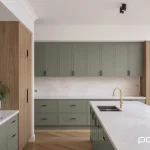The trend to design home extension has seen remarkable growth, especially in the wake of the pandemic. With more time spent at home, many Australians are now investing in property renovations that create functional, flexible spaces to better accommodate modern living. Whether it’s adding a home office, a family entertainment zone, or extra living space, home extensions can dramatically increase both the usability and value of a property. This guide walks you through the essential steps to design home extensions that maximises both space and property value.
Current Extension Trends
Home extension trends in Australia reflect a shift towards sustainability, open-plan layouts, and the use of natural light. Here are some of the most popular ideas driving today’s renovations and extensions, helping homeowners design home extensions that suits their needs:
- Eco-Friendly Materials: More homeowners are choosing sustainable options like recycled wood, natural stone, and energy-efficient insulation. Not only are these materials better for the environment, but they also enhance the comfort and efficiency of the home.
- Open-Plan Extensions: An open-plan layout can transform a home by creating a seamless flow between kitchen, dining, and living areas, making spaces feel larger and more inviting.
- Natural Light: Extensions that maximise natural light are increasingly popular. Skylights, large windows, and bi-fold doors help reduce reliance on artificial lighting while creating a bright and airy space.
Popular Types of Extensions
- Multi-Purpose Rooms: Designed for flexibility, these spaces can serve as home offices, guest rooms, or children’s play areas. Many homeowners are choosing to design home extensions that incorporates these flexible spaces.
- Home Offices: With remote work becoming mainstream, dedicated home offices are now a priority in many renovation plans. Including a home office when you design home extensions adds significant functionality.
- Entertainment Areas: Adding a home theatre or games room can make your home more enjoyable and add significant resale value. When you design home extensions with entertainment in mind, the possibilities are endless.
Cost Breakdown by Area
A well-planned budget is essential for any renovation. The cost to design home extensions can vary widely depending on the type of room, the level of finish, and local construction rates. Here’s a rough cost guide to help you anticipate expenses for different types of extensions:
1. Kitchen Extension
- Basic Finish: Starting from around $30,000. Kitchen renovations play a huge role when you design home extensions.
- Premium Finish: Can range up to $80,000, including high-end appliances, custom cabinetry, and quality finishes
2. Living Room or Lounge Extension
- Basic Finish: Approx. $25,000 – $50,000
- Premium Finish: Ranges from $60,000 to over $100,000 for high-end materials and built-in furnishings
3. Bathroom and Laundry Renovations
- Bathroom Renovations: Basic bathroom renovators typically charge from $15,000 for a simple upgrade, while premium bathroom renovations can go up to $40,000. As you design home extensions, the addition of an extra bathroom can add significant value.
- Laundry Renovations: A basic laundry room remodel starts at around $5,000, with premium finishes and cabinetry going up to $15,000.
Essential Planning Steps
Effective planning is crucial when you design home extensions that meets both current needs and future goals. Here are the key steps to set you on the right path:
- Set a Budget: Determine how much you’re willing to invest and leave a buffer for unexpected costs. When you design home extensions, consider the potential return on investment, particularly if you’re expanding to increase property value.
- Choose a Qualified Renovation Contractor: Work with experienced contractors who specialise in renovations and extensions. A reliable renovation contractor can provide detailed quotes, manage your budget, and ensure quality craftsmanship from start to finish.
- Acquire Necessary Permits: Most extensions require council approval. Consult your builder or an architect to ensure all paperwork is in order before construction begins. The proper permits are essential as you design home extensions that aligns with local building codes.
- Manage Your Timeline: Plan for contingencies, as delays can occur. Creating a realistic timeline with your builder can help prevent disruptions and ensure a smooth process from start to finish when you design home extensions.
Choosing the Right Builder for Your Project
Selecting the right builder is crucial to achieving your desired result as you design home extensions. Here’s what to look for in a renovation and extension builder:
- Experience and Expertise: Choose a builder with a proven track record in home extensions and renovations. Look for examples of their work that reflect the style you’re aiming for.
- Transparent Pricing: A good builder provides a detailed and transparent quote, so you understand exactly what’s included and where costs may arise.
- Good Communication Skills: Communication is key throughout the process. You want a builder who keeps you informed and is responsive to your questions or concerns.
- Positive Reviews: Check reviews, testimonials, and if possible, talk to previous clients. A builder with happy customers is likely to deliver a quality outcome as you design home extensions.
Maximising Value with Smart Design Choices
Design choices can significantly impact both the functionality and value of your home extension. Here are some expert recommendations to design home extensions that offers flexibility and maximises value:
- Flexible Layouts: Incorporate sliding doors, removable partitions, or multi-functional furniture to adapt the space as needs change.
- Energy Efficiency: Invest in energy-efficient windows, solar panels, and smart heating and cooling systems. These not only reduce utility costs but also make your home more attractive to future buyers.
- Indoor-Outdoor Flow: Consider bi-fold doors or large windows that open up to outdoor spaces. This not only enhances the look and feel of your home but also increases usable living space when you design home extensions.
- Quality Over Quantity: It’s better to focus on a high-quality finish for a smaller space than to stretch your budget on a larger extension with low-grade materials. High-quality finishes make a lasting impression and can significantly add to your home’s value.
Supporting Data
- Home Renovation Sydney Statistics: According to recent surveys, over 50% of Sydney homeowners have invested in renovations, with an increasing number opting to design home extensions to add value and functionality.
- Expert Insight: Leading architects suggest that well-planned extensions can add up to 30% to a property’s value, particularly when they improve the layout, functionality, and sustainability of the home.
These figures underscore the importance of planning, design, and working with experienced builders to maximise the benefits as you design home extensions.
Conclusion
Designing a home extension that maximises space and value is a process that requires careful planning, a realistic budget, and the right professionals. By staying informed about current trends, selecting quality materials, and making thoughtful design choices, homeowners can create an extension that not only meets their immediate needs but also adds lasting value to their property.
If you’re considering a home extension and looking for reliable, experienced renovation and extension builders, call us at 02 8105 0064. See our latest updates here at Renovation Masters in Sydney for expert advice and quality services. Our team is here to guide you from blueprint to budget, ensuring your vision becomes a reality.





